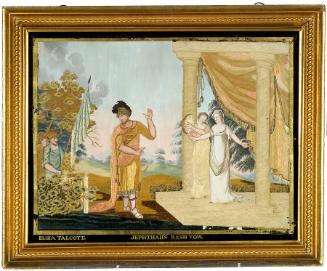Hector's Tomb
EmbroidererAttributed to
Sarah Lawrence
(American, 1784 - 1866)
Date1797-1805
MediumEmbroidery; silk thread and paint on a plain-woven silk ground; glass with black and gold paint; wood with gilded paint
DimensionsPrimary Dimensions (height x width): 25 1/4 x 22 1/4in. (64.1 x 56.5cm)
ClassificationsTextiles
Credit LineGift of Mary E. Hastings
Object number1922.6.1
DescriptionNeedlework picture worked in gold, yellow, tan, cream, brown, green and white silk thread on a plain-woven silk ground, using satin stitch and other stitches; the picture is titled "Hector's Tomb" and is in the original gold-painted frame. The picture shows a stone tomb with a standing and a seated woman in cloaks mourning over the tomb; at the base of the tomb is a child. The standing woman is holding a small wreath. The faces, hair and limbs of the women and child are hand-painted directly onto the silk ground. The picture is behind glass that is painted black at the edges; the title is painted in gold at the bottom. The frame consists of one deeply curved band of molding with a line of beads applied inside. The frame is backed with paper printed with a blue, black and white geometric design.
Stitches: The primary stitch on the needlework picture is satin stitch; it also includes encroaching satin and long and short.
Condition: The gold paint on the frame has minor flaking. The silk thread is faded slightly.
NotesSubject Note: Homer's epic poem, The Iliad, tells the story of the Trojan War, fought between the Greek army and the city of Troy. Prince Hector was the leader of Troy's army. Late in the war, he was killed by the Greek hero Achilles. Because Hector had killed Achilles' dearest friend, Patroclus, Achilles desecrated Hector's body. Through the intervention of the gods, King Priam, Hector's father, met with Achilles and secured the return of his son's body so it could receive proper burial. The poem closes with Hector's funeral rites. Lines 935-961 of Book 24 in Robert Fitzgerald's 1974 translation read:Stitches: The primary stitch on the needlework picture is satin stitch; it also includes encroaching satin and long and short.
Condition: The gold paint on the frame has minor flaking. The silk thread is faded slightly.
"In a golden urn they put the bones/
shrouding the urn with veiling of soft purple./
Then in a grave dug deep they placed it/
and heaped it with great stones. The men were quick/
to raise the death-mound, while in every quarter/
lookouts were posted to ensure against/
an Akhaian [Greek] surprise attack. When they had finished/
raising the barrow, they returned to Ilion [Troy],/
where all sat down to banquet in his honor/
in the hall of Priam king. So they performed/
the funeral rites of Hektor, tamer of horses."
(Hudson 8/15/2005)
Status
Not on view












